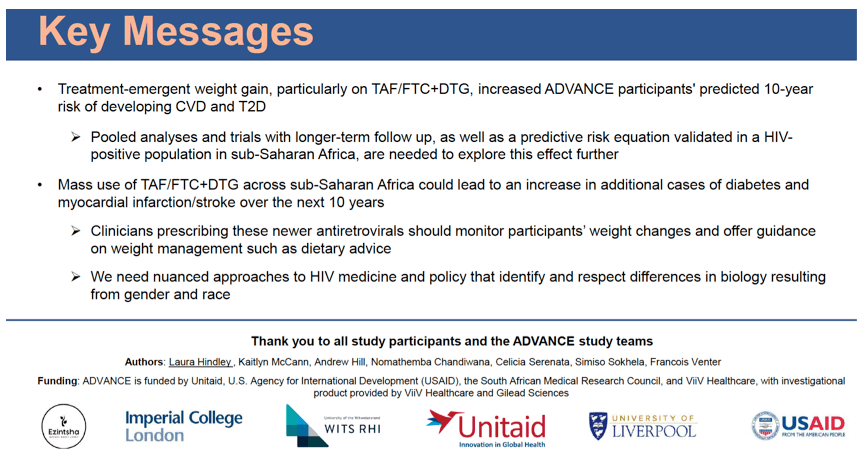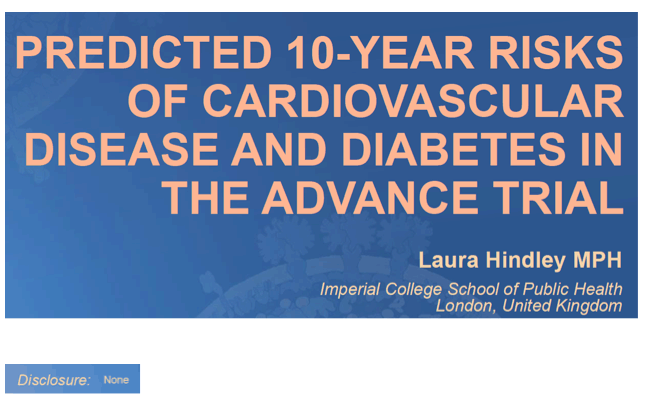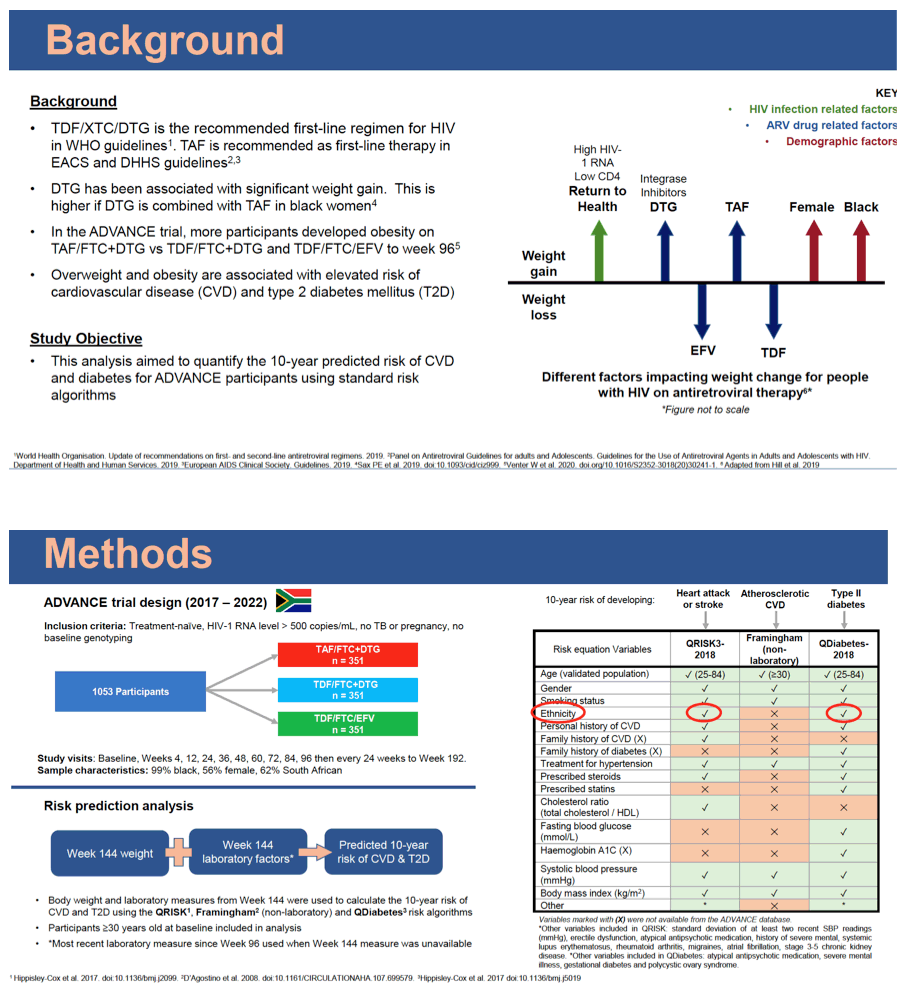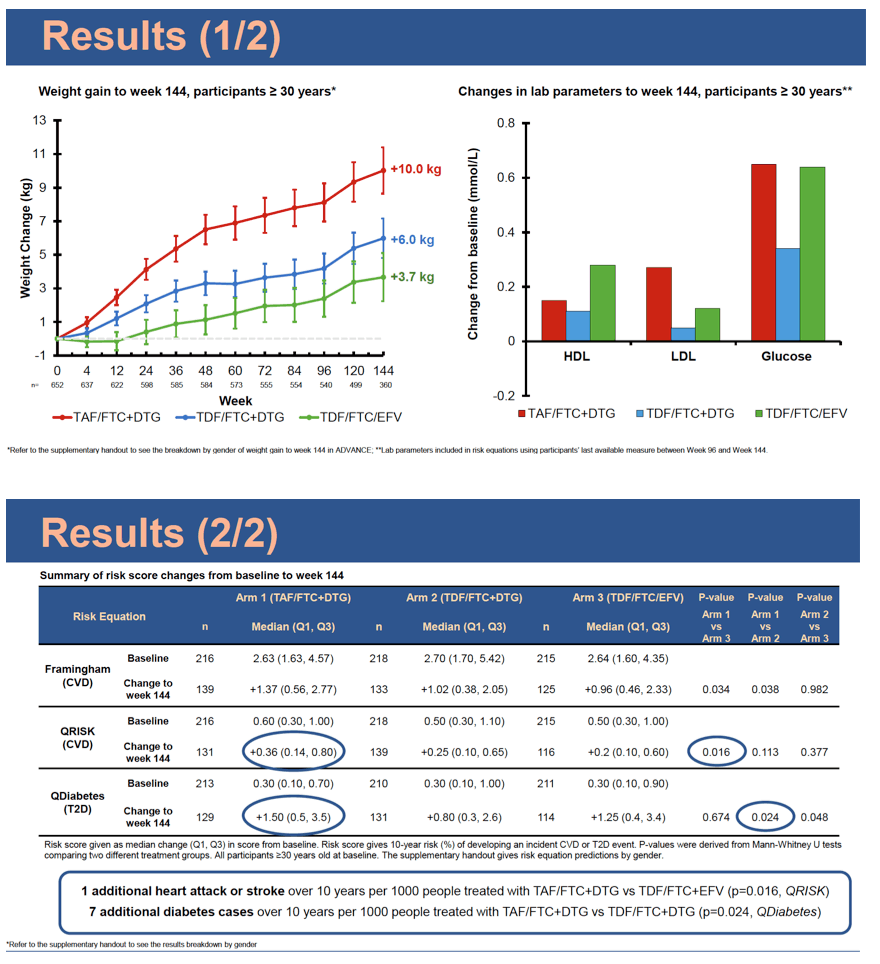 |
 |
 |
| |
PREDICTED 10-YEAR RISKS OF CARDIOVASCULAR DISEASE AND DIABETES IN THE ADVANCE TRIAL
|
| |
| |
CROI 2021 March 6-10 Reported by Jules Levin
Laura Hindley1, Kaitlyn Mccan1, Simiso Sokhela2, Nomathemba Chandiwana2, Francois Venter2, Celicia M. Serenata2, Andrew Hill3
1Imperial College London, London, UK, 2Ezintsha, Johannesburg, South Africa, 3University of Liverpool, Liverpool, UK
Background: In the ADVANCE trial, more participants developed obesity on TAF/FTC+DTG vs TDF/FTC+DTG and TDF/FTC/EFV. Overweight and obesity are associated with elevated risk of cardiovascular disease (CVD) and type 2 diabetes (T2D). This study aimed to quantify these risks using standard risk algorithms. New analysis of the FDA FAERS database showed more reports of myocardial infarction (MI)/T2D for people on integrase inhibitors. Plasma EFV concentrations have been associated with raised glucose concentrations in HIV-infected South Africans.
Methods: In ADVANCE, 1053 treatment-naïve participants (99% black, 56% female, 62% South African) were randomised to 192 weeks of TAF/FTC+DTG, TDF/FTC+DTG or TDF/FTC/EFV. Body weight change was evaluated to week 144. Low-density lipoprotein, high-density lipoprotein, total cholesterol, fasting glucose and systolic blood pressure were measured at baseline, week 96 and week 144. These variables were used to calculate the 10-year risk of CVD (MI/ stroke) and T2D based on weight change to week 144 using the QRISK, Framingham (BMI-based) and QDiabetes risk algorithms. QRISK and QDiabetes were adjusted for black African race. Participants ≥30 years with laboratory data for parameters in the risk equations were included. Differences between groups were tested using non-parametric methods.
Results: 397, 386 and 374 participants were included in Framingham, QRISK and QDiabetes respectively. Vital signs and laboratory parameters were similar at baseline between arms. Mean weight gain to week 144 was +9.5kg (TAF/FTC+DTG), +6.1kg (TDF/FTC+DTG), +3.6kg (TDF/FTC/EFV). At week 144, participants on TAF/FTC+DTG had greater predicted 10-year risk of developing CVD compared to TDF/FTC/EFV (p=0.016), and of T2D compared to TDF/FTC+DTG (p=0.024)(Table 1). CVD risk was greater for men, T2D risk was greater for women. From QRISK, CVD risk was 0.02% greater for women on TAF/FTC+DTG vs TDF/FTC/EFV. For men, this risk increase was 0.2%, equivalent to 2 additional MI/stroke cases/ 1000 men. Predicted T2D risk was greater for women on TAF/ FTC+DTG vs TDF/FTC+DTG by 0.9%, equivalent to 9 additional T2D cases/ 1000 women. For men, this increase was 0.75% or 7.5 additional T2D cases/ 1000 men.
Conclusion: Treatment-emergent weight gain, particularly on TAF/FTC+DTG, increased participants' predicted 10-year risk of developing CVD and T2D. These results support WHO recommendations for TDF/FTC+DTG as 1st-line therapy, with TAF/FTC+DTG only used for patients with osteoporosis or renal impairment.




|
| |
|
 |
 |
|
|